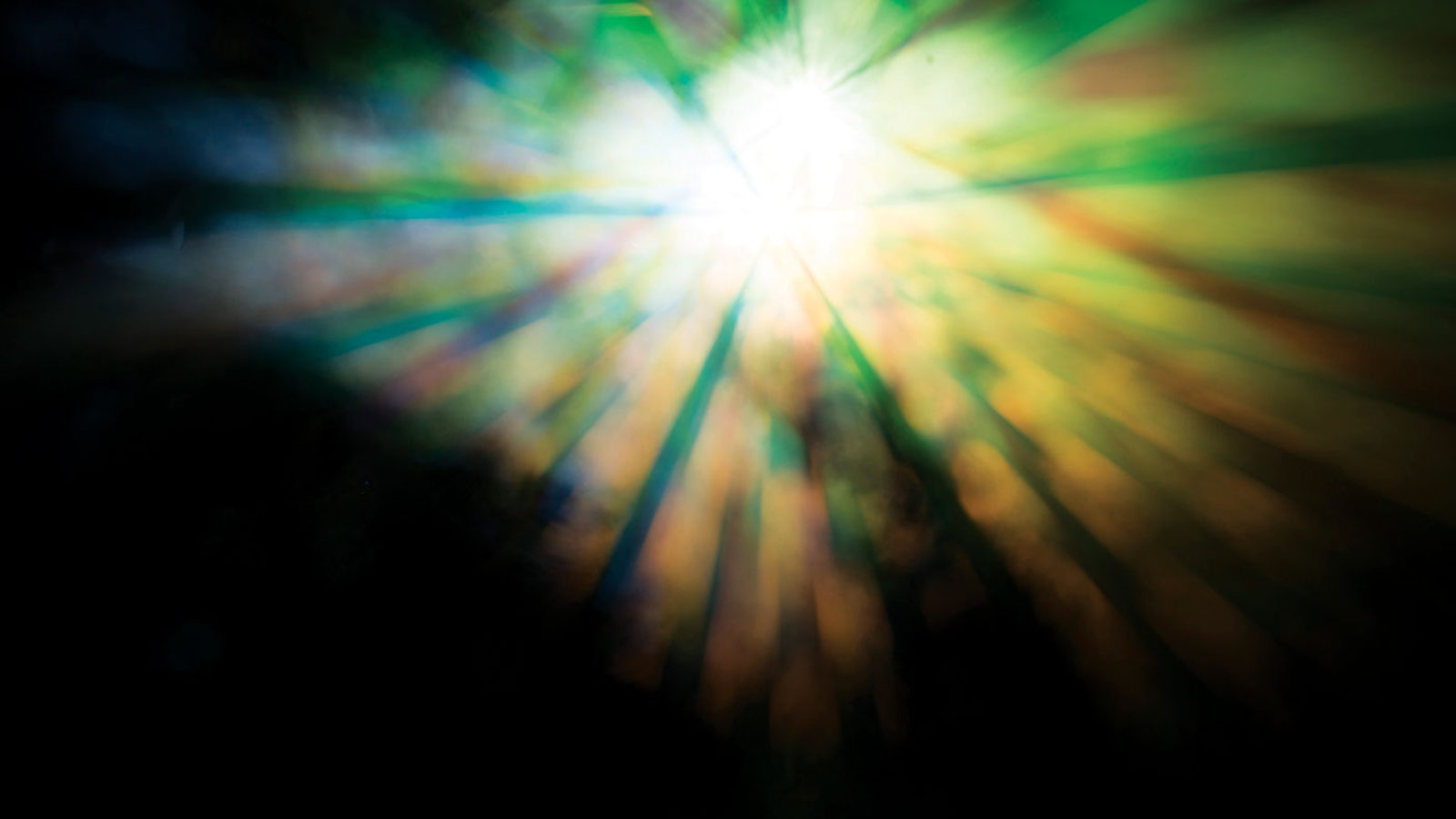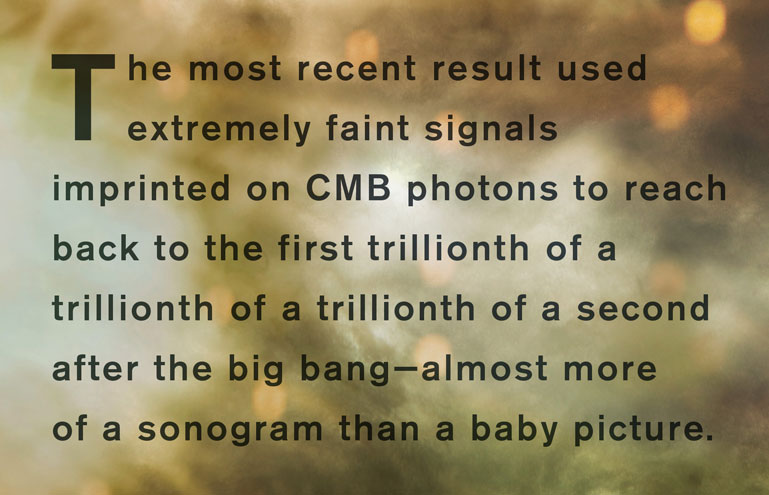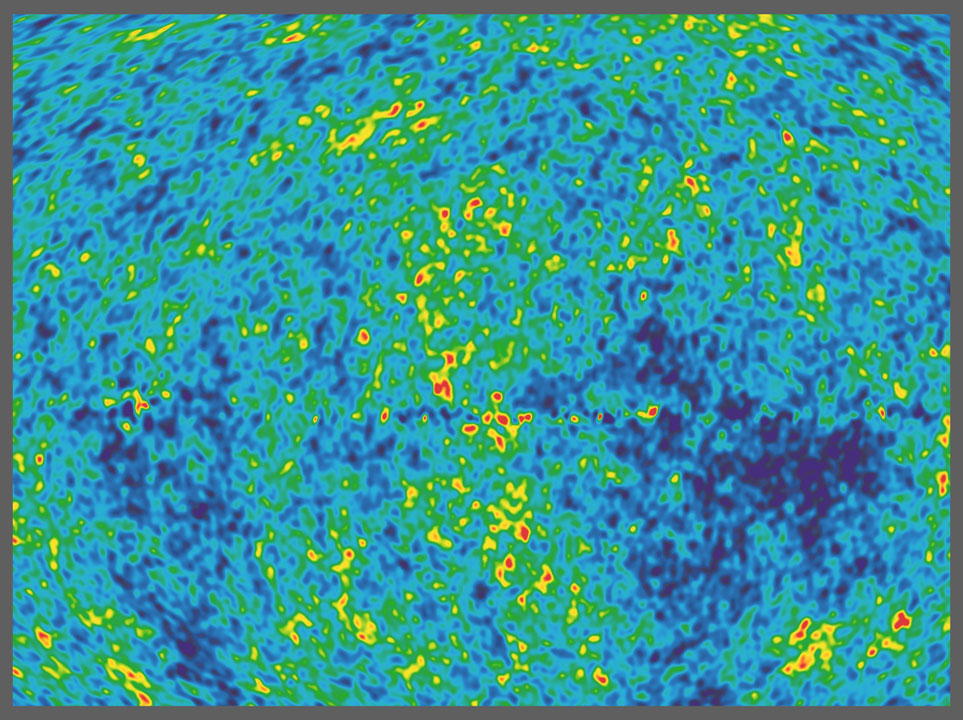Fifty years ago, two radio astronomers from Bell Labs discovered a faint, ever-present hum in their telescope that they couldn’t identify. After ruling out radio broadcasts, radar signals, a too-warm receiver and even droppings from pigeons nesting inside the scope, they realized they’d found a soft cosmic static that originated from beyond our galaxy. Indeed, it seemed to fill all of space.
Fast-forward five decades, and the static has a well-known name: the cosmic microwave background, or CMB. Far from a featureless hum, these faint, cold photons, barely energetic enough to boost a thermometer above absolute zero, have been identified as the afterglow of the big bang.
This light—the oldest ever observed—offers a baby picture of the very early universe. How early? The most recent result, announced on Saint Patrick’s Day 2014 by the researchers of the BICEP2 experiment, used extremely faint signals imprinted on CMB photons to reach back to the first trillionth of a trillionth of a trillionth of a second after the big bang—almost more of a cosmic sonogram than a baby picture. This image offered the first direct evidence for the era of cosmic inflation, when space itself ballooned outward in a turbocharged period of expansion.
CMB photons have more to tell us. Combined with theoretical models of cosmic growth and evolution, ongoing studies will expand this view of the very early universe while also looking forward in time. The goal is to create an entire album chronicling the growth of the universe from the very moments of its birth to today.
Further studies promise clear insight into which of the many different models of inflation shaped our universe, and can also help us understand dark matter, dark energy and the mass of the neutrino—if researchers can read the CMB in enough detail.
That’s not easy, though, because the afterglow has faded. During its epic 13-billion-year-plus journey, light that originally blazed through the universe has stretched with space itself, its waves growing billions of times longer and cooler and quieter.
Relic radiation
The Standard Model of Cosmology says that about 13.8 billion years ago, the universe was born from an unimaginably hot, dense state. Before a single second had ticked away, cosmic inflation increased the volume of the universe by an amount that varies according to the particular model, but always features a 10 followed by about 30 to 80 zeroes.
When inflation hit the brakes, leftover energy from that expansion created many of the particles we see around us today: gluons, quarks, photons, electrons and their bigger brethren, muons and taus, and neutrinos. Primordial photons scattered off free-floating electrons, bouncing around inside the gas cloud that was the universe. Hundreds of thousands of years later, the cosmic cloud of particles cooled enough that single protons and helium nuclei could capture the electrons they needed to form neutral hydrogen and helium. This rounded up the free electrons, clearing the fog and releasing the photons. The universe began to shine.
These photons are the cosmic microwave background. Although now weak, they are everywhere; CMB photons bathe the Earth—and every other star, planet, black hole and hunk of rock in the universe—in their cold light.
Cosmic sonograms
The latest big discovery coaxed from CMB data peeks back into the earliest moments of the universe.
Using cutting-edge sensors, the BICEP2 telescope located at the South Pole detected a type of signal that has been predicted at one strength or another by every version of inflation theory out there: a type of polarization to the CMB light called “B-mode polarization.”
According to the theories, tiny variations in the energy of the pre-inflation universe caused primordial gravitational waves—ripples in the fabric of space-time—that ballooned outward with inflation. Even before they became the CMB, photons interacted with these ripples, causing the photons’ wavelengths to take on a slight twist. It was this twist that the BICEP2 collaboration measured as a swirling polarization pattern.
“BICEP2 clearly detected B-mode polarization at precisely the angular scales predicted by inflation,” says Chao-Lin Kuo, one of four principal investigators on the experiment and a scientist at Stanford University and SLAC National Accelerator Laboratory. “This is an incredible combination of big theoretical ideas, teamwork, focus and cutting-edge technologies. The development of mass-produced superconducting polarization detectors and quantum current sensors made a real difference to our success in getting to B-modes first.”
A discovery of this magnitude calls for further confirmation—not of the signals, which were very clear, but of their inflationary origin. If it holds, the B-mode polarization signals will also give scientists more details about the inflationary event that took place. For example, it can tell us about the energy scale of the universe—essentially the amount of energy poured into the instant of inflation. The BICEP2 result puts this at about 1016 billion electronvolts. For comparison, the Large Hadron Collider’s most powerful proton beams smash together at 104 billion electronvolts—a number with 12 fewer zeros than the first.
Such information can help scientists determine which of the many different models of inflation actually describes the beginning of our universe. To Walt Ogburn, a postdoctoral researcher at Stanford University and a member of the BICEP2 team, the first view of primordial B-mode polarization does more than turn inflationary theory into fact: It breaks through into uncharted territory in high-energy physics. “What drove inflation is not in the Standard Model,” Ogburn says. By definition, proof of inflation offers evidence that there’s something more out there that’s not yet discovered, and that something big we don’t yet fully understand helped drive the evolution of the early universe.
Baby picture
The detection of B-mode polarization is the latest in a long string of scientific discoveries base on information coaxed from these scarce, faint photons.
The first successes in probing the CMB came almost two decades after it was identified. Beginning with Relikt-1, a Soviet satellite-based experiment launched in 1983, and continuing all the way up to the present, a variety of balloons and satellites have mapped the temperature of the CMB. They found it was 2.7 kelvin across the whole of the sky, with only small, scattered variations in temperature of about one part in 100,000.
In that temperature map cosmologists saw the image of the infant universe.
“We’ve learned an enormous amount from the temperature [patterns],” says Lyman Page, also a cosmologist at Princeton. Page was one of the original researchers on what, until this year, was probably the best-known CMB instrument, the Wilkinson Microwave Anisotropy Probe. He now focuses on the Atacama Cosmology Telescope, and few people know more about how to make the CMB give up its secrets.
Page explains that both the overall sameness of the temperature and the pattern of these minor variations told cosmologists that when the universe began, it was compact enough to be in thermal equilibrium: a dense, nearly featureless plasma of immense energies. But within that plasma, quantum fluctuations caused tiny variations in energy density.
Then, during cosmic inflation, space grew enormously in all directions. This magnified the variations like an inflating balloon expands ink spots sprayed on it into larger and larger blotches.
This is the same process that generated the gravitational waves imaged by BICEP2. The gravitational waves left telltale swirling polarization patterns in the CMB without doing much else. However, the dense areas—“blotches” on the otherwise smooth map of the sky—became important seeds of all structures in the universe.
They grew and cooled, morphed from variations in energy density to variations in matter density. The denser regions attracted more matter as the universe continued to expand, eventually building up large-scale structures we see stitched across the universe today.
When combined with other theories and measurements, Page says, the temperature variations provide strong evidence that our universe began with the big bang. They have also helped cosmologists improve estimates for how much dark matter and dark energy existed in the early universe (and likely still exist today), and backed the notion that the geometry of the universe is flat.
“The CMB is really a beautiful signal,” says the University of Chicago’s John Carlstrom, who, like Page, is an expert in extracting information from a few faint photons. He leads the South Pole Telescope project, which uses several instruments mounted on a telescope not too far from BICEP2, to learn more about the CMB. The signal, he continues, offers “very precise measurements of conditions at recombination,” which is the name given to the time when the CMB photons escaped from the primordial cloud of cooling plasma.
These temperature maps—in combination with the primordial B-mode signals detected by BICEP2—cover a time period from a tiny fraction of a second after the birth of the universe to about 380,000 years after that. In the coming years, cosmologists want to expand that picture to include everything that’s happened in the more than 13 billion years since recombination. Many predictions exist for what happened during this huge span of time, but scientists need rock-solid empirical data to compare their theoretical models against.
Filling in the photo album
CMB photons have more important informationto offer, and a new generation of experiments is listening to what they have to say. Situated mostly on the high, dry, cold deserts of the South Pole and the Atacama Plateau in Chile, or in high-flying balloons that rise above much of the atmosphere, new instruments use the CMB to refine our knowledge of how the universe has evolved.
As the CMB photons traveled through the universe, they were pulled this way and that by gravity, bearing witness to everything that happened on their way from the beginning to now. Using these photons as messengers, the new instruments are helping scientists carefully tease out the story of what the photons saw along their journey.
Interactions with the hot gas that surrounded and infused galaxy clusters, for example, left a mark on some of the photons in the form of a tiny boost in energy, which is detectable as a very slight adjustment to the temperature map.
The new instruments also measure a different type of B-mode polarization, added to the CMB photons long after inflation. This type of twist occurs when the photons brush up against the gravity of large-scale cosmic structures comprising both regular matter and dark matter, and it was detected for the first time just last year by SPTpol, a polarization-sensitive microwave camera mounted on the South Pole Telescope.
Taken together, these measurements of tiny temperature differences and polarization can help scientists map matter distributions over time and improve estimates of how much of the universe is made up of dark matter versus the normal matter we see in stars and planets. It can also help tease apart the difference between expansion due to the momentum left from the big bang and expansion due to dark energy. This will yield an accurate four-dimensional map of the universe, revealing the movement of matter through space and time.
Further measurements are poised to reveal more information about the contributions to our cosmos of a tiny particle with big implications: the neutrino. Its mass is currently not known to any respectable precision, yet this number is of great importance to predictions regarding the neutrinos’ influence on the growing universe.
Experiments so far have seen three types of neutrinos, yet some theories predict a fourth type, called a sterile neutrino, as well.
“Neutrinos are the second most plentiful particle in the universe—after photons,” says Bradford Benson, a scientist at Fermilab and a member of the SPTpol team. “The total mass of all the neutrinos in the universe should at least equal the mass of all the stars.”
When the universe was smaller, that neutrino mass could have had a significant influence on the universe’s developing structure. As the universe expanded, two things happened: Clumps of heavier, slower-moving particles grew even bigger by pulling in more matter, while the light, speedy neutrinos escaped; and space expanded while the number of neutrinos stayed the same such that, as their density decreased, their gravitational influence decreased as well.
As they traveled among the growing cosmic structures, the CMB photons recorded these changes in the relative density of neutrinos. Scientists are now mining this record to determine how the influence of neutrinos has evolved over time, and can use the information to estimate their mass. Combined with CMB measurements of dark matter and expansion due to dark energy, scientists expect this research to refine their view of the universe past and present, revealing how matter and energy interacted in the early universe to make the universe we see today.
Old light, new science
Using the CMB to discover primordial gravitational waves has been a tremendous step forward. “What’s truly amazing is that the CMB may still hide more secrets even after we found the holy grail,” says Kuo, referring to BICEP2’s discovery.
Temperature maps, scattered photons and twisted light still have more to tell us. Over the next decade, CMB measurements are poised to help us understand the immense forces of the big bang, illuminate the physics of the early universe and explain the matter and energy we see around us today.
“Having this signal has helped turn cosmology into a precision science,” Carlstrom says. “We’ve gone from being told, ‘You guys don’t really know what you’re measuring’ to having independent measurements with levels of precision that rival particle physics.”
And the benefits are only set to increase. “The study of the CMB is a fantastic field, a very rich field,” Page says. “The microwave background is still going to be a useful tool in 20 years.”
That’s not bad for a few frigid photons.










